The 50 Best Leg Exercises for 2024
When you do leg workouts, you should hit the entire posterior chain: calves, quads, hamstrings, glutes, lats, and the muscles along the spine. You should also work your core, improve your balance, and hone things like grip strength, which pays dividends in the long run to improving overall performance.
For the sake of your physique and training results, here are 50 of the best leg exercises to ensure you're building three-dimensional muscle.
Related: Unlock Free Strength Gains With These 6 Mobility Exercises

milan2099 / Getty Images
50 Best Leg Exercises
Mix and match these exercises to create various leg workouts. Not sure how many reps to go with? Use our rep range guide. We highlight the benefits and arguments for using high reps (15+), low reps (5 or less), and moderate reps (8-12) depending on your goals.
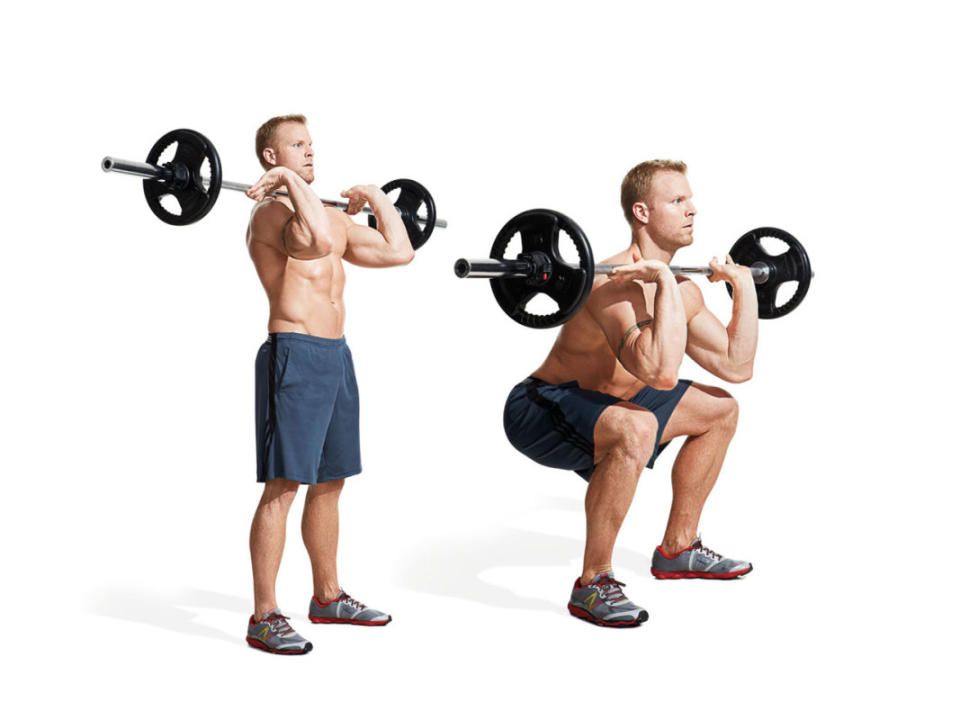
- Set a barbell on a power rack at about shoulder height.
- Grab the power with an overhand grip at shoulder width and raise your elbows until your upper arms are parallel to the floor.
- Take the bar out of the rack and let it rest on your fingertips.
- Your elbows should be all the way up throughout the movement.
- Step back and set your feet at shoulder width with toes turned out slightly.
- Squat as low as you can without losing the arch in your lower back.
- glutes
- calves
- hamstrings
- quads
Make sure your elbows are pointed up/forward at all times during the rep. This will help you maintain good posture and keep your body from angling forward.
Variation:This move can also be done with dumbbells. Rest one on each shoulder and do a rep with elbows pointed up and triceps forward.
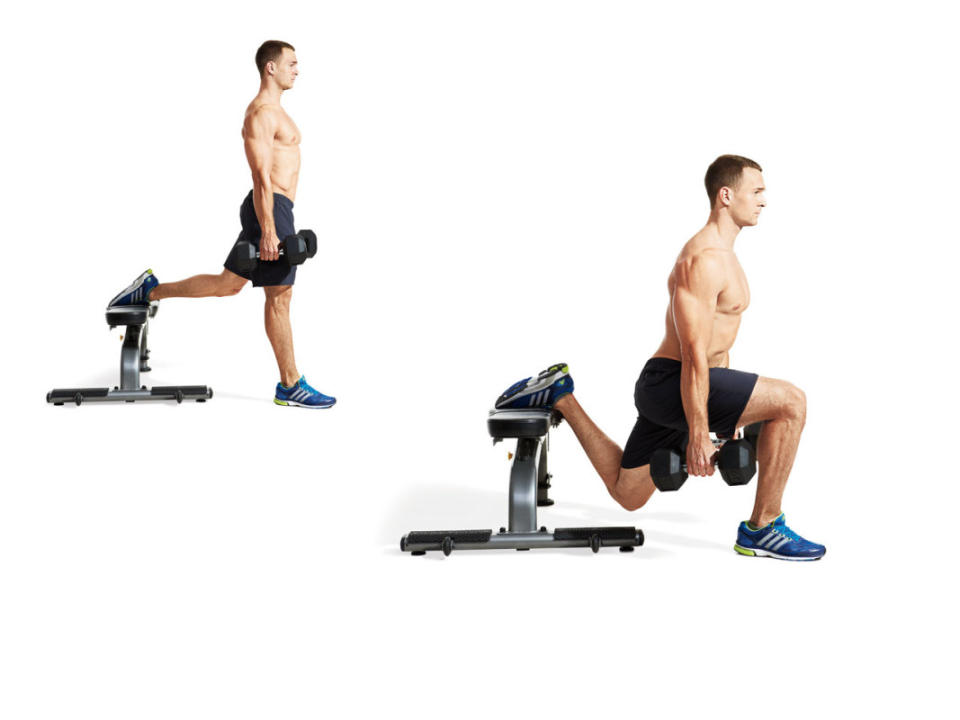
- Stand lunge-length in front of a bench.
- Hold a dumbbell in each hand and rest the top of your left foot on the bench behind you.
- Lower your body until your rear knee nearly touches the floor and your front thigh is parallel to the floor.
- calves
- quads
- glutes
- hamstrings
- hip flexors
Single-leg training can yield serious strength gains. Keep your dip shallow for more emphasis on the quads, and deepen it for more emphasis on working the glutes.
Variation:This move can be done with or without weights. For beginners, try starting by interlocking your fingers behind your head. Then transition to holding a medicine ball before moving to dumbbells or kettlebells.

- A killer deadlift variation, hold a barbell with a shoulder-width grip and stand with feet hip-width apart.
- Bend your hips back as far as you can.
- Allow your knees to bend as needed while you lower the bar along your shins until you feel a stretch in your hamstrings.
- Keep your lower back in its natural arched position throughout.
- hamstrings
Contract your glutes as you return to starting position. This should keep the strain off of your lower back.
Variation:There's also a dumbbell single-leg variation of this move, where you hold a dumbbell in each hand at your sides and lean forward while lifting one leg straight behind you. As your chest comes forward, the dumbbells should shift from your sides to directly over your planted foot.
Return to starting position by lowering your back leg as you come up and returning the dumbbells to your sides.

- In a squat rack or cage, grasp the bar as far apart as is comfortable and step under it.
- Place it on your lower traps, squeeze your shoulder blades together, push your elbows up and nudge the bar out of the rack.
- Take a step or two back and stand with your feet at shoulder width and your toes turned slightly out.
- Take a deep breath and bend your hips back, then bend your knees to lower your body as far as you can without losing the arch in your lower back.
- Push your knees out as you descend.
- Drive vertically with your hips to come back up, continuing to push your knees out.
- glutes
- quads
- calves
- hamstrings
Try practicing with an unweighted barbell a few times to get comfortable with the proper form before adding weight. Proper form includes engaging your core so to not round your back.
Variation:There are numerous variations to this move. Two of them are the overhead squat–where you perform the move while holding the bar over your head, and goblet squat–where you hold the weight in front of you.

- Stand behind a bench or another elevated surface that will put your thigh parallel to the floor when you step your foot onto it.
- Hold a dumbbell in each hand and step onto the bench, but leave your trailing leg hanging off.
- Step back down to starting position and repeat using the other leg.
- quads
- glutes
- calves
Be mindful to place your entire foot onto the bench or elevated surface as you step up. Only catching it with your toe or heel could cause some imbalance.
Variation:This move could include a reverse lunge, where you drive your trailing knee up toward your chest as you step up, and then step back into a reverse lunge once your back on the floor.
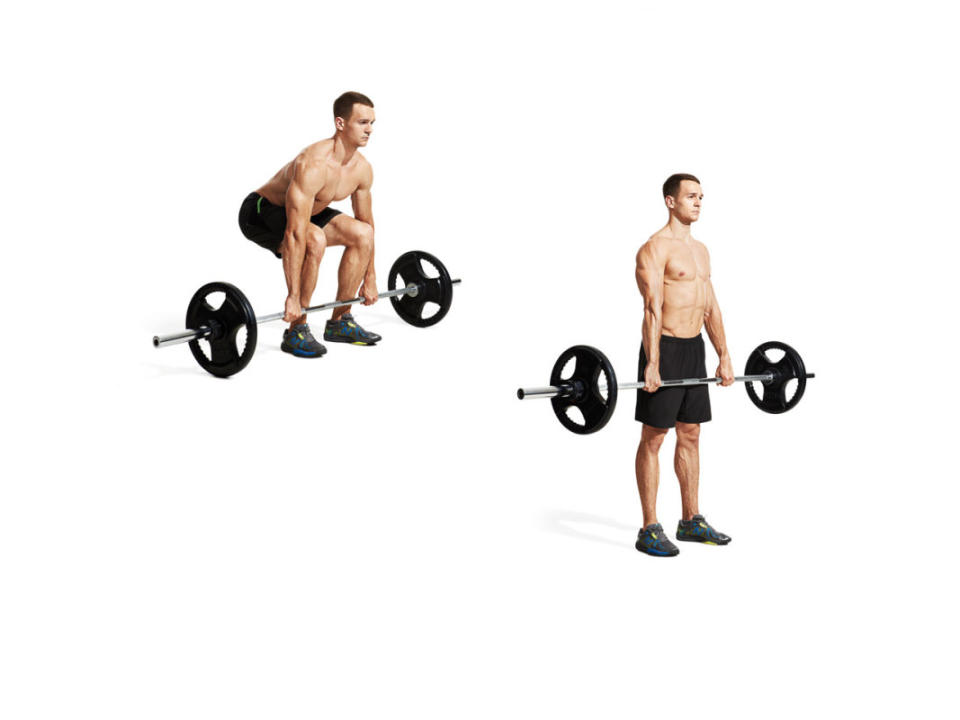
- Stand straight up with feet hip-width apart and shins one inch away from the bar.
- Grip the bar with a double pronated or reverse grip, bend knees and push them into your straight arms.
- Bring your chest up as much as possible and look straight ahead. Keeping your back flat, extend your hips to stand up, pulling the bar up along your legs to lockout.
- Once you've got that right you can try these 4 ways to break your deadlift record.
- glutes
- hamstrings
Bend your knees without going into a full squat. This will allow you to maintain proper leverage as you lift.
Variation:This move can be done using a kettlebell or single dumbbell if you're just beginning or working out in a smaller area.

- Brace your abs with heels on a stability ball.
- Raise your hips into the air, but keep your knees straight.
- From there, bend your knees and roll the ball back toward you.
- Keep your hips elevated throughout the set. Check out more Swiss-Ball leg exercises.
- glutes
- hamstrings
Keep your core engaged throughout this move so that your hips don't dip. Also, be sure to perform this move on a surface that allows the stability ball to move easily but not slip.
Variation:This move is pretty straightforward, though some may prefer to perform it without shoes to get better leverage.

- Hold a dumbbell in one hand and stand on the opposite leg.
- Bend your hips back and lower your torso until you feel your lower back is about to lose its arch.
- Squeeze your glutes and extend your hips to come up.
- glutes
- hip abductors
Keep your head aligned with your shoulders as you lower your torso. This will help to maintain form in your back.
Variation:This move can be done without weight as well by stretching your arms forward as you lower your torso.
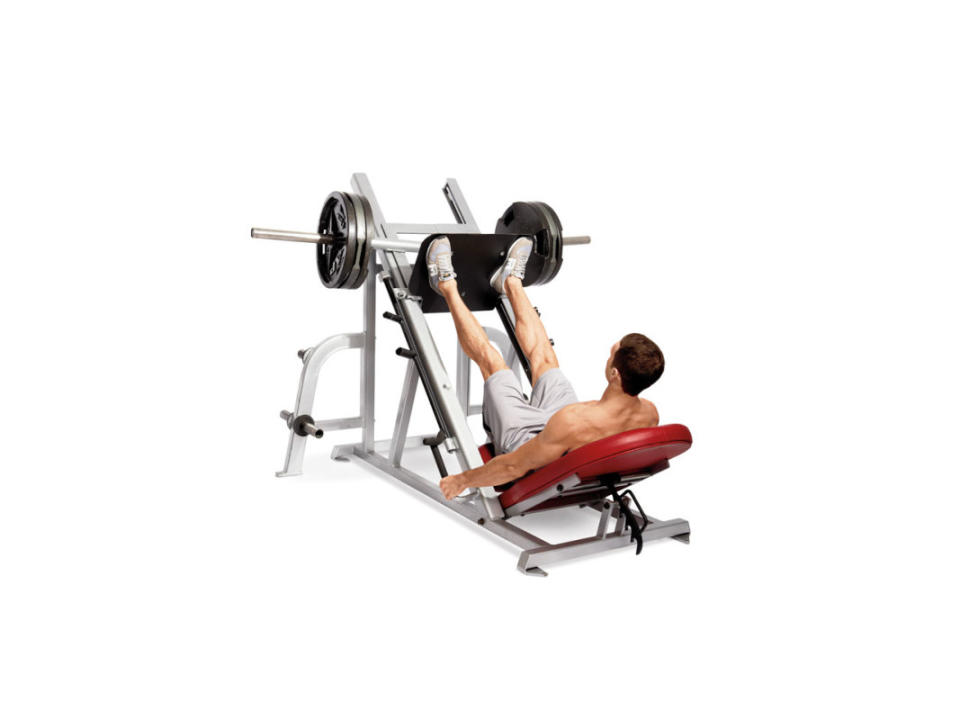
- Adjust the seat of the machine so that you can sit comfortably with your hips beneath your knees and your knees in line with your feet.
- Remove the safeties and lower your knees toward your chest until they’re bent 90 degrees and then press back up.
- glutes
- hamstrings
- quads
- calves
Be careful not to go too low or you risk your lower back coming off the seat (which can cause injury).
Variation:Some may prefer to sit more horizontally than at an angle so the weight is more in front than above you.

- Stand with your toes on a block or step and hold onto something sturdy for support.
- Raise your heels to come up on the balls of your feet, and then lower your heels until you feel a stretch in your calves.
- calves
Stand with your toes on the edge of the step, but not at too much of an edge to risk slipping off.
Variation:This move can be done with weight–adding ankle weights or holding a dumbbell in one hand.

- Stand with your feet hip width, holding a dumbbell in each hand.
- Step forward with one leg and lower your body until your rear knee nearly touches the floor and your front thigh is parallel to the floor.
- Step forward with your rear leg to perform the next rep.
- glutes
- quads
It's easy to drift or zig-zag when walking. Find a focus point and keep your head there so that you can walk in a straight line with knees straight.
Variation:This move can be done by carrying the dumbbells on your shoulders or above your head when you walk for an added challenge. Or you can do it with no weight, placing your hands on your hips as you walk.
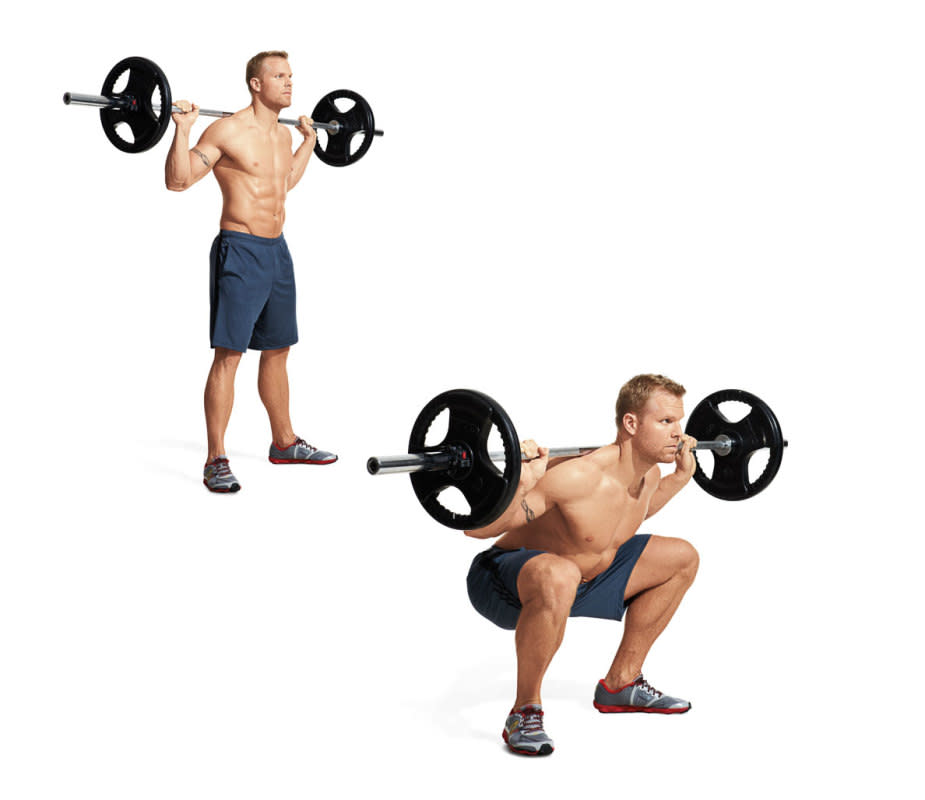
View the original article to see embedded media.
- Set up in a squat rack or cage.
- Grasp the bar as far apart as is comfortable and step under it.
- Squeeze your shoulder blades together and nudge the bar out of the rack.
- Step back and stand with your feet at shoulder width and your toes turned out slightly.
- Take a deep breath and tuck your hips back, then bend your knees to lower your body as far as you can without losing the arch in your lower back.
- Push your knees out as you descend.
- Hold the bottom position for two seconds before returning to start.
- quads
- glutes
- calves
Keep your neck neutral at all times to maintain proper form, especially during the pause.
Variation:You can take multiple pauses in a single set before returning to starting position, though proper form is key. This move can also be done with no weight and your arms stretched out in front of you.

- Stand with back straight, head forward, and arms at your sides–then take a step back with your right foot.
- Lower your body until your front thigh is parallel to the floor and your rear knee nearly touches the floor.
- Keep your torso upright.
- Step forward to return to the starting position.
- Complete 3-5 reps on one leg, then switch legs. That’s one set.
- quads
- calves
Your step back should cause you to feel the stretch in your calf and hamstring, but it shouldn't be so wide that it pulls your hips backward.
Variation:This move can be done with weight, using dumbbells in each hand.

- Hold the weights at shoulder level and stand with feet shoulder-width apart and toes turned slightly out.
- Squat down as low as you can without losing the arch in your lower back.
- quads
- glutes
- hamstrings
- calves
Drop your weight onto your heels when lowering into your squat. This will keep your torso from leaning forward and losing leverage in the exercise.
Variation:Numerous variations include the goblet squat, the barbell squat, and the front squat. You can also use resistance bands in place of dumbells.

- Stand with feet hip-width apart and the kettlebell on the floor.
- Grasp the weight with both hands (palms facing you) and, keeping your lower back flat, extend your hips to raise it off the floor.
- From there, take a deep breath and bend your hips back, allowing the weight to swing back between your legs.
- Explosively extend your hips and exhale—allowing the momentum to swing the weight up to shoulder level.
- Control the descent, but use the momentum to begin the next rep.
- quads
- glutes
Let the kettlebell do the work. The goal is to use the momentum of the weight to continue the swing instead of straining against it to pull it forward.
Variation:There aren't many different ways of doing this move. The main thing you can change is the amount of weight.

- Stand with feet shoulder-width apart and squat down until your thighs are about parallel to the floor but no deeper.
- Jump as high as you can.
- Land with soft knees and begin the next rep.
- calves
- glutes
- quads
Perform this exercise on a semi-soft but sturdy surface in order to protect your joints. Good options are a workout mat, grass, or carpet.
Variation:This move can be done with weight–holding dumbbells in each hand either at the sides or the shoulders.
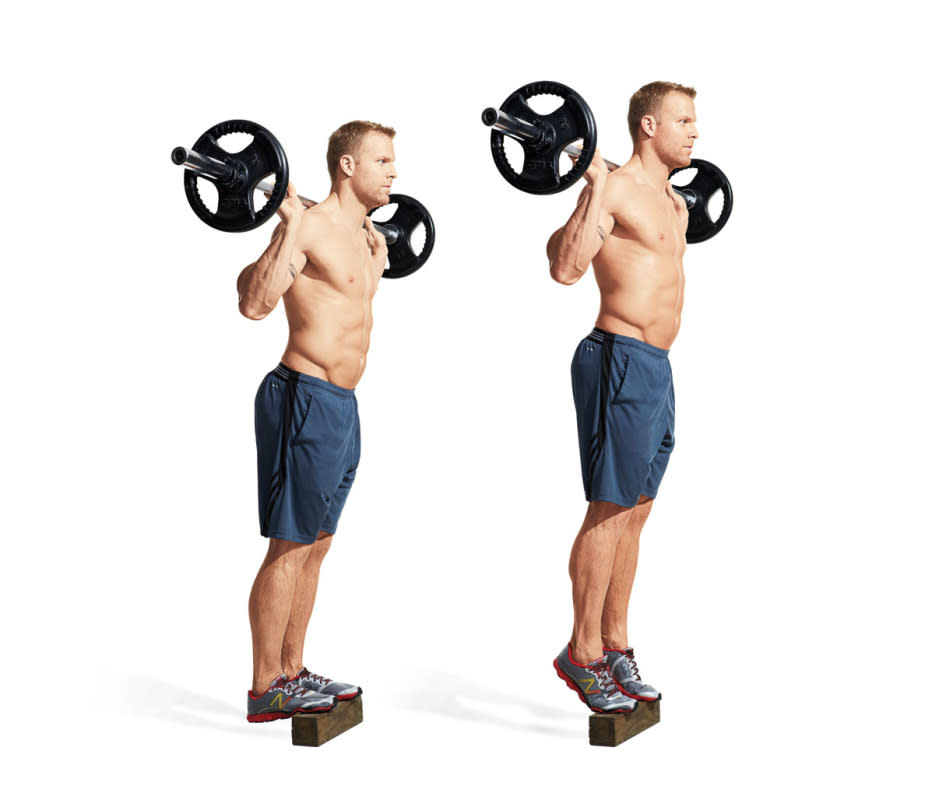
- Place a block, step, or weight plate on the floor.
- Grasp a barbell and hold it on the backs of your shoulders, as in a squat.
- Place your toes on the block so your calves are stretched, but make sure you can maintain balance.
- Raise your heels to come up onto the balls of your feet.
- calves
- glutes
For added challenge, hold for 1-2 seconds at the top of your raise and lower slowly.
Variation:If you're dealing with any back or shoulder issues, another version of this move can be done using resistance bands. Wrap the band around the balls of your feet from a seated position and pull on the band slowly so your toes are pointed toward you.

- Kneel down in a lunge position with your right leg in front, and rest your back knee on a towel or mat, if available.
- Extend your left hand above your head and let your right hand hang at your side.
- Contract your left glute and push your hips forward until you feel a stretch in the front of your hip.
- Hold for 30 seconds.
- hip flexors
- quads
- glutes
Since this is a stretch and not a lift, it may feel natural to rock into it. Hold steady and breath through the duration of the stretch to let your muscles get the full impact.
Variation:A good variation includes a rotation, where instead of lifting one hand, you turn your torso toward the open side and place both hands on the floor.

- Stand on your right leg and pick your left one up off the floor.
- Raise both arms in front of you to act as a counterbalance.
- If you have light weights or something similar to help you keep your balance, use it.
- Bend your hips and knees and lower your body as low as you can.
- Come back up.
- quads
- glutes
Keep your head and shoulders level. This will help you maintain balance.
Variation:This move can be done by placing both hands on a wall and walking them down it as you lower into the squat.

- Stand tall with feet flat on the floor.
- Jump straight up, flexing your calves.
- Land softly, absorbing the force by dropping into a half squat.
- calves
- quads
- glutes
Instead of landing on flat feet, which can cause stress on your joints, let the balls of your feet take first contact, then roll onto your heels and into the half squat.
Variation:You can add weight to this move by holding dumbbells in each hand, or add resistance by performing this in a pool.
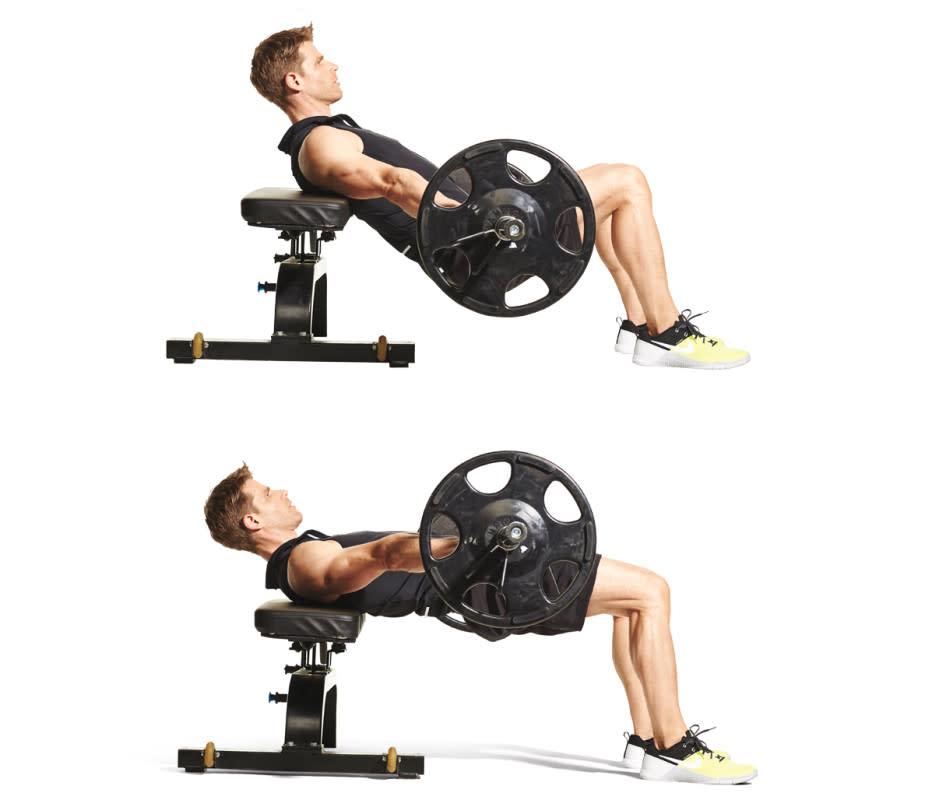
- Rest your upper back on a bench and sit on the floor with legs extended.
- Roll a loaded barbell up your thighs until the bar sits on your lap (you may want to place a towel or mat on your hips or attach a pad to the bar for comfort).
- Brace your abs and drive your heels into the floor to extend your hips, raising them until your thighs and upper body are parallel to the floor.
- hip abductors
- glutes
- quads
- hamstrings
Keep your feet flat on the floor for the entire rep, resisting going up onto the balls of your feet. To help with this, make sure your knees are bent at a 90-degree angle.
Variation:Try this move with a dumbbell in each hand, a medicine ball on your lap, or a barbell with no plates.

- Lie on your back on the floor and bend your knees so your feet rest on the floor close to your butt.
- Brace your abs and drive your heels into the floor to raise your hips into the air.
- From there, walk your feet out in a V shape, taking small steps with your heels forward and away from the midline of your body.
- Keep your hips up.
- Continue until your legs are extended and then walk them back in. That’s one rep.
- glutes
- hip abductors
Go slowly. The goal is to use your body weight to fully engage your glutes.
Variation:If walking your feet back in to starting position is too difficult, you can bring your hips down and start from the beginning of the rep.

- Lie on your back on the floor and bend both knees so that your feet rest on the floor close to your butt.
- Brace your abs and raise one leg just below the point of your bent knee, straitening it with toes pointed up.
- Squeeze your glutes, bring your hips up, and drive the heel of the other foot into the floor.
- Bridge up until your body is in a straight line.
- glutes
- hamstrings
- quads
Let your hinge stop at your upper-back with each bridge and not your neck.
Variation:For added challenge, bring your straight leg up at a lower angle
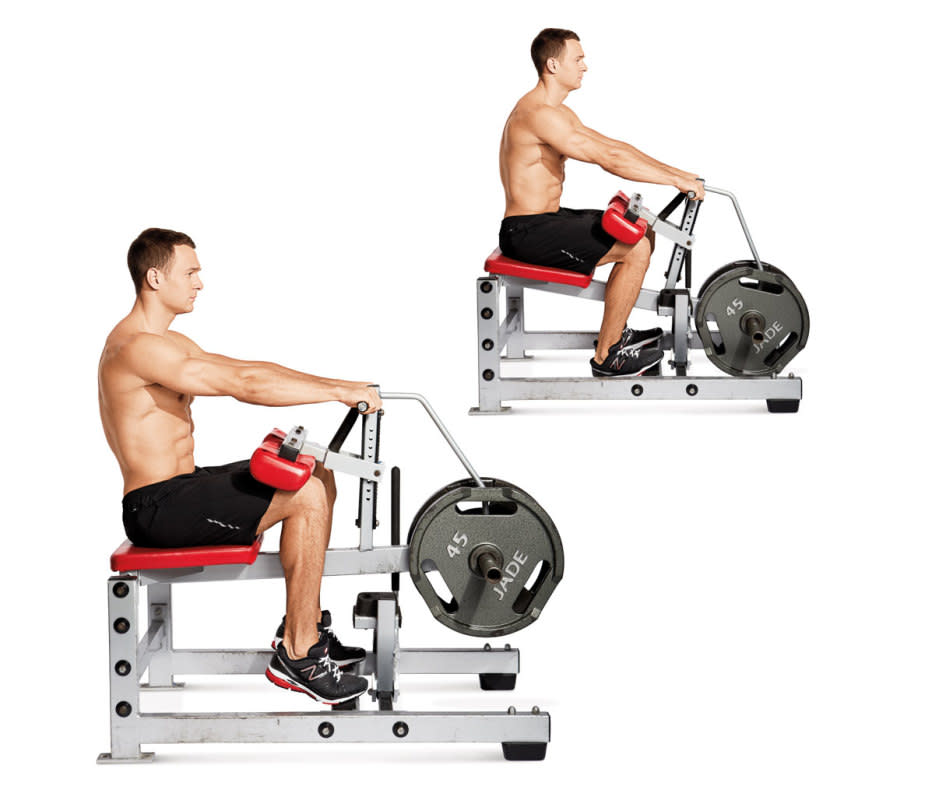
- Use a seated calf raise machine, or sit on a bench and rest the balls of your feet on a block or step (and hold dumbbells on your thighs for resistance).
- Perform a calf raise, but with hips and knees bent 90 degrees.
- calves
- quads
Aim for three sets of 15-20 reps.
Variation:Instead of using a calf raise machine, you can use a barbell or dumbbells across your lap.

- Place the ball against a wall and stand with your back against it, holding it in place.
- Place your feet shoulder-width apart and turn your toes out about 15 degrees.
- Squat down as low as you can, rolling the ball down the wall as you descend.
- hamstrings
- quads
- glutes
Press your back against the ball so that it's stable, but not so hard that you're feeling undo pressure on your back.
Variation:You can perform this move while holding dumbbells.

- Sit on the floor and place your hands on the floor under your shoulders, fingers pointing in front of you.
- Place your feet shoulder width and squeeze your glutes.
- Push through your heels as you bridge your hips up.
- Your body should form a table, with your torso and hips parallel to the floor.
- Hold for two seconds.
- glutes
If you're feeling strain in your wrists or shoulders, turn your fingers outward for better support.
Variation:There is another version of this move where you let your head fall back behind the shoulders at the top of the move, instead of keeping a neutral neck.

- Hold the weight close to your chest at shoulder level with both hands on the handle and palms facing each other.
- Squat down as deeply as you can, then press the bell straight out in front of you with arms extended.
- Bring it back to your chest and repeat for reps while maintaining the squat position.
- quads
- glutes
- calves
Foot position is key for this move. You want to place your feet slightly wider that shoulder-width with toes slightly pointed outward.
Variation:This move can be done with a medicine ball, dumbbell, or any other weight that doesn't put strain on the shoulders. You can also perform this move against a wall for additional support.
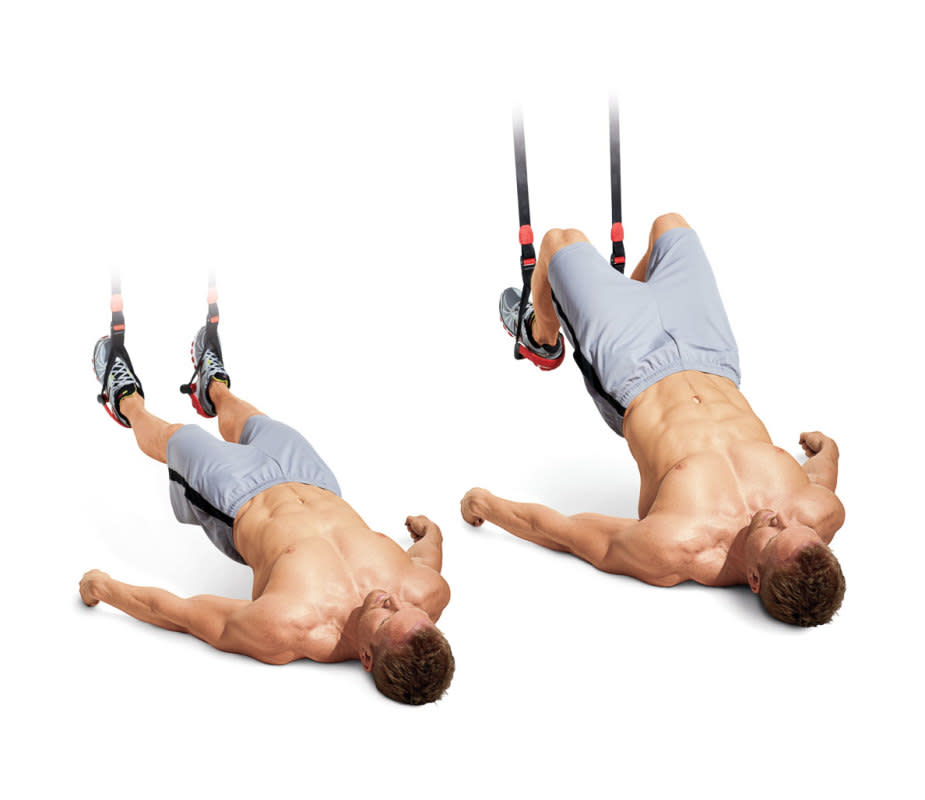
- Rest both feet in the foot cradles of a suspension trainer with legs straight.
- Bridge your hips up so your body forms a straight line, then bend your knees, curling your heels toward your butt.
- glutes
- hamstrings
- calves
The closer you place your hands to your sides, the more support you’ll get.
Variation:There aren't many different variations of this move, however you may substitute a foam roller in place of a suspension tool.

View the original article to see embedded media.
- Hold the bar overhead and step forward with your left leg.
- Lower yourself until your left thigh is parallel to the floor and your rear knee nearly touches the floor.
- glutes
- hamstrings
- quads
Form is paramount. Be sure that the weight is stable overhead before entering into the lunge. Both parts of the move shouldn't be done simultaneously.
Variation:This move can be done with various weights or no weight at all–just stretch your arms above your head.

- Use a standing calf raise machine, or stand on a block or step with a dumbbell in one hand while holding on to something for support with the other.
- Lower your heels toward the floor until you feel a stretch in your calves.
- Drive the balls of your feet into the foot plate and contract your calves, raising your heels as high as possible.
- Control the descent on each rep.
- calves
Place your feet at a position where your heels can dip below the threshold of the step, but not too far back to risk slipping off.
Variation:This move can be done with or without additional weight.
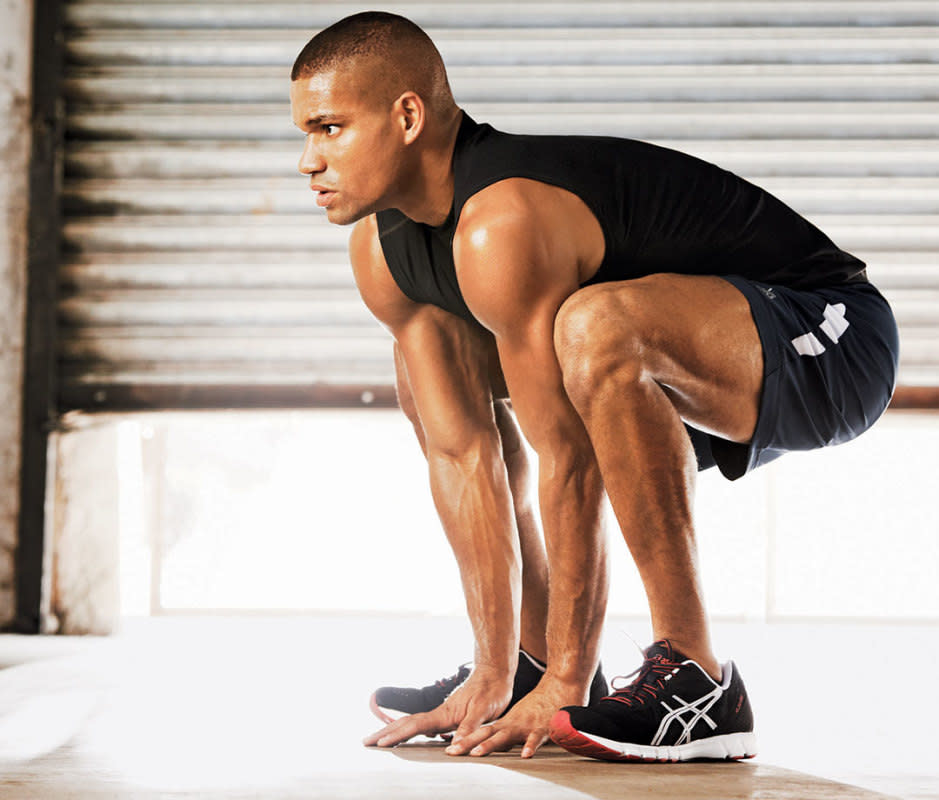
- Bend at the waist, grabbing underneath your big toes (or touch palms to floor).
- Keep your arms straight inside your knees, pull hips down until they’re between your ankles, and lift your chest.
- Tuck your chin and try to straighten your legs, holding on to your toes as you straighten the hips and knees.
- hamstrings
Go slowly when moving into the standing position, so to feel the stretch without causing injury.
Variation:There is a more advanced version of this move done entirely on the toes, where the heels never touch the floor.

- Hold a dumbbell or kettlebell with two hands against your chest.
- Squat by sitting hips back and down, keeping your weight in your heels, without lifting the toes.
- Maintain contact between the kettlebell and your chest.
- Your elbows should touch your knees at the bottom of the movement.
- Rise and extend powerfully through your hips to stand.
- quads
- hamstrings
Hold for a beat at the bottom of the move to ensure you don't bounce or rock your hips.
Variation:For a fuller range of motion, let your elbows drop slightly below your knees, but not so much that the weight dips below your chest.

- Stand on your right leg, with your left foot off the ground.
- Squat slightly on your right leg and use your leg and glute to jump laterally (to the left).
- Land on the opposite leg, maintaining balance.
- Repeat on the other side.
- glutes
- quads
- calves
Be sure to engage your arms for more explosion and balance.
Variation:This move can be done slowly, where you hold for a beat on each leg, or fast in a skater motion from side to side.

- Start in a squat position with back flat, hips back, and a miniband around your ankles.
- Taking small steps, walk forward, keeping feet in line with hips.
- quads
- glutes
Use a band that allows movement with resistance, but not one that makes it difficult to walk.
Variation:This move can also be done using ankle weights instead of a band.

- Press back against a wall, then slide hips down until knees are at a 90-degree angle and thighs are parallel to floor.
- Hold weight in front of chest.
- Hold for at least 30 seconds.
- quads
- glutes
Keep your hips slightly above your knees when in the sitting position to maintain leverage.
Variation:This move can be done with arms extended outward for additional shoulder work.
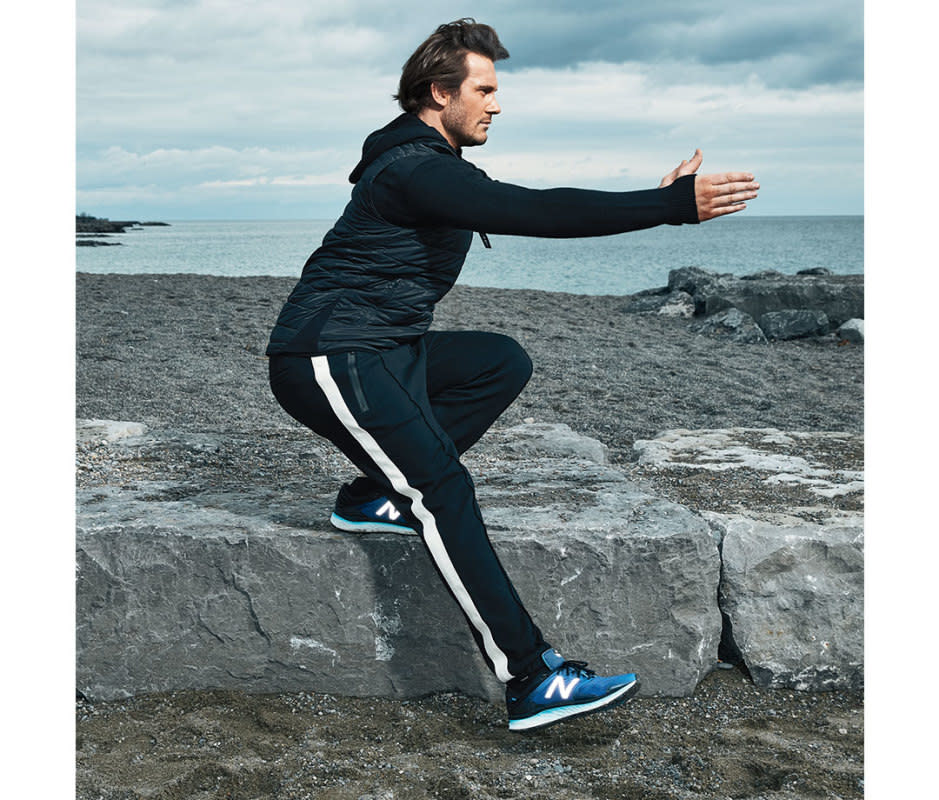
- As a progression to the pistol squat, stand parallel to a ledge with one foot hanging off.
- Extend arms and the free leg out in front of you.
- Bend your working knee, hinging at hips, to lower into a squat.
- Keeping your back straight and torso upright, as you try to touch your working hamstring to the calf.
- Squeeze glutes and drive through heels to stand. Repeat on the other side. When you progress, stand on a flat surface and repeat the above steps.
- hip abductors
- calves
- glutes
- hamstrings
Start with 3-5 sets of assisted pistol squats–using a chair or box–before moving to unassisted.
Variation:This move can be done with weight, but it's recommended to master the assisted and unweighted versions before moving to this stage.
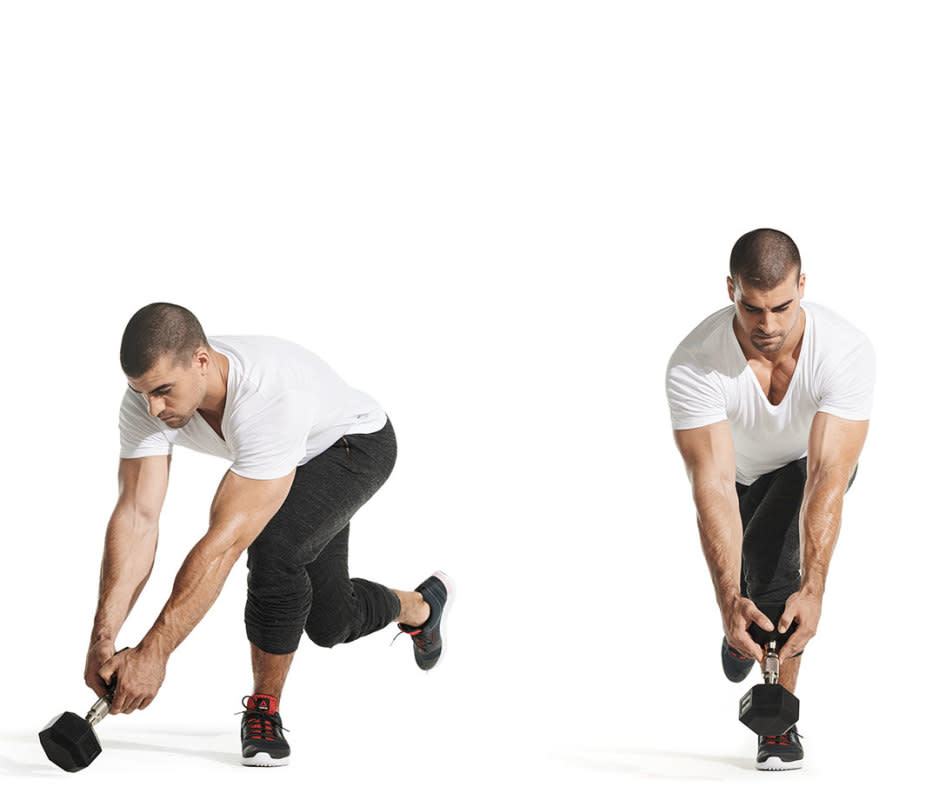
- Stand on one leg, holding one end of a dumbbell with both hands.
- Bend forward at the hips and then bend your knee and, keeping your chest up, lower your body while reaching slightly to your left side.
- Imagine a clock face on the floor and touch the end of the dumbbell at 11 o'clock.
- Stand back up and squat down again and touch 12 o'clock. Repeat, and reach to the right to touch 1 o'clock. Each touch is one rep. Repeat on the other leg.
- quads
- glutes
- hamstrings
- hip abductors
- calves
Opt for a lighter weight dumbbell that can be manageable for this move.
Variation:This move can be done without weight or chair-assisted.
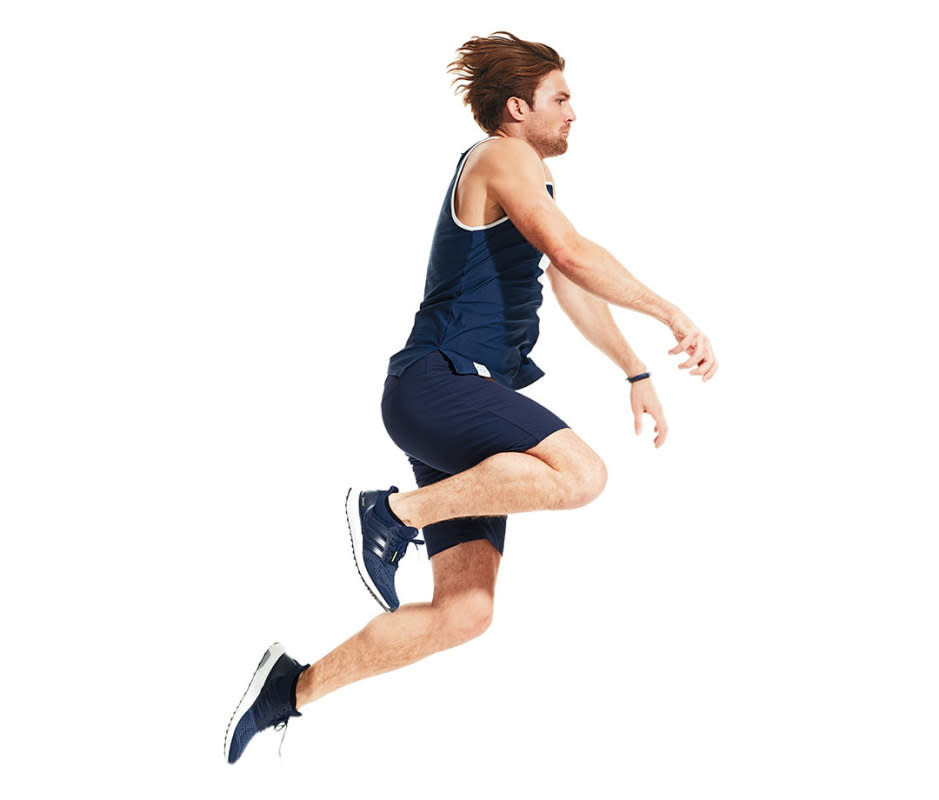
- Stand on one leg and squat halfway down.
- Place the toe of the opposite foot on the grass behind you for balance.
- Explode off the working leg, jumping up and forward, and land on the same leg.
- Hold the landing for three seconds and begin your next jump. Be conservative with your distance and height, since the impact will be hard.
- calves
- quads
- glutes
Engage your arms in the movement for peak explosion and balance.
Variation:Land on two feet instead of one, unless you're performing a series of 2-3 jumps in a row per set.

- Set up 2 boxes, a 20-inch and a 12-inch, 2 feet apart.
- Stand between them. Squat, then explode up, landing on the boxes in a split position, one foot on each box.
- Most of your weight is in the front foot, on the high box, while the back foot acts to balance you.
- calves
- hamstrings
- quads
- glutes
One box should be at a higher elevation than the other, similar to stairs.
Variation:This move can be done on the floor with no boxes.

- Squat and jump 180 degrees counter-clockwise.
- Imagine there’s a mirror behind you and you want to face the mirror.
- Now squat while facing the mirror and jump back the way you came.
- Squat again; this time clockwise.
- calves
- quads
- hamstrings
- glutes
Engage your arms for full explosion and balance.
Variation:You can nix the 180-degree turn, if there's an imbalance issue.

- Start on hands and knees, toes touching a wall.
- Slide right knee back toward wall, moving top of foot up wall.
- Put your left foot on the floor, and push your torso up.
- Adjust your left foot so the knee is square, and place hands on the left knee.
- Adjust the back knee so you feel a stretch but pose is not painful.
- Breathe, then switch sides.
- quads
- hamstrings
Perform this move on a mat to keep stress off of your knees.
Variation:If this move bothers your knee, perform a side-lying quad stretch by lying on your side, knees pulled into chest, holding your top ankle with your top hand. Pull the top leg behind your body to feel a stretch in the front of your thigh and hip. Hold for two seconds, then return to the starting position.
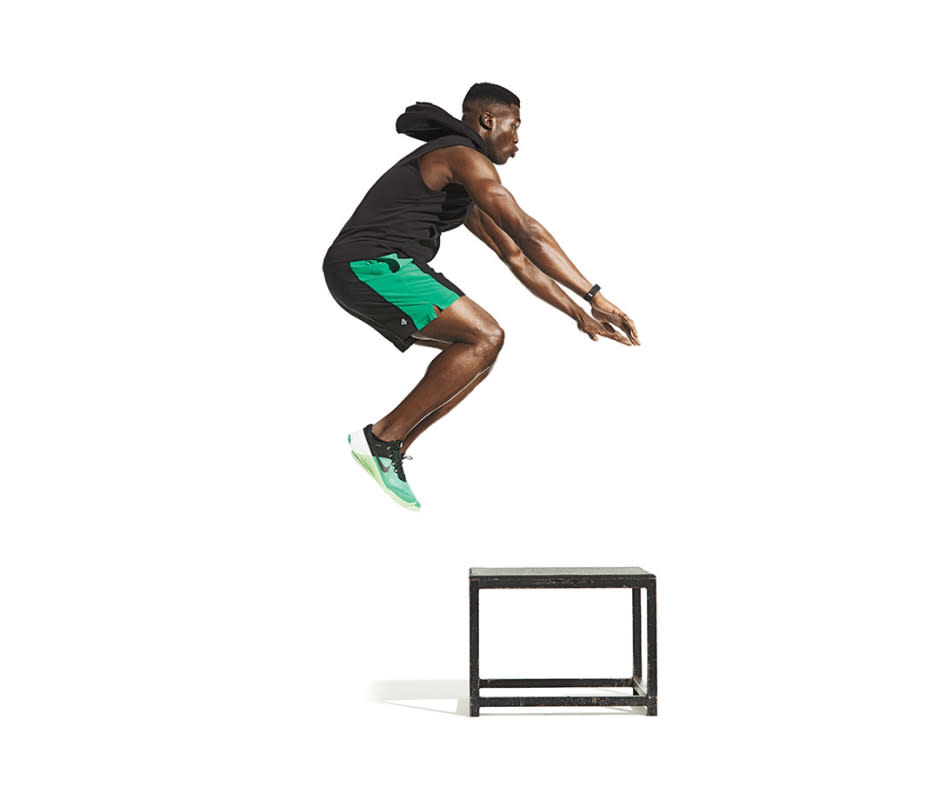
- Stand on two legs facing a box.
- Bend slightly at the knees to load your hips and swing your arms down and back.
- Using momentum, swing arms forward and jump onto the box, holding a stable landing position for two seconds.
- Step off the box and repeat.
- quads
- hamstrings
- calves
- glutes
Be sure to land flat-footed and not on the balls of your feet.
Variation:This move can be done landing on one leg and alternating to the other on the next rep.
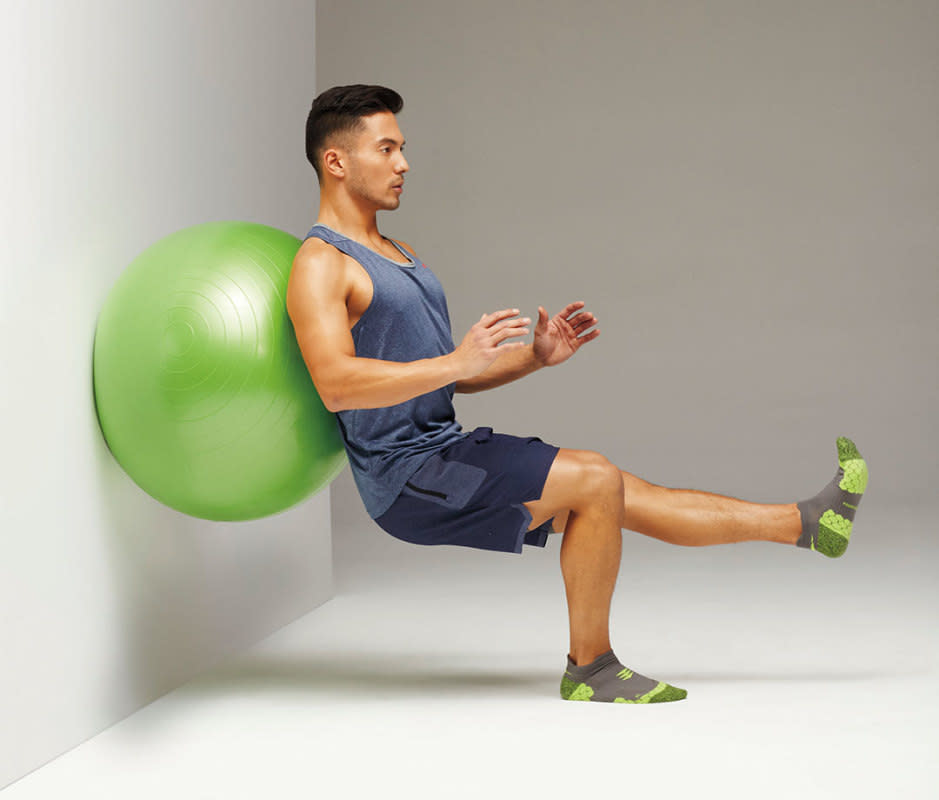
- Stand with the ball between your lower back and a wall.
- Straighten left leg and flex foot to start.
- Lower hips, allowing the ball to travel up the back, until the left leg is parallel to the floor.
- Reverse to start for one rep. Do all reps with the left leg raised, then switch legs.
- quads
- glutes
- hamstrings
Keep your core tight and shoulders engaged for stability.
Variation:This move can be done by holding onto a chair or bench.
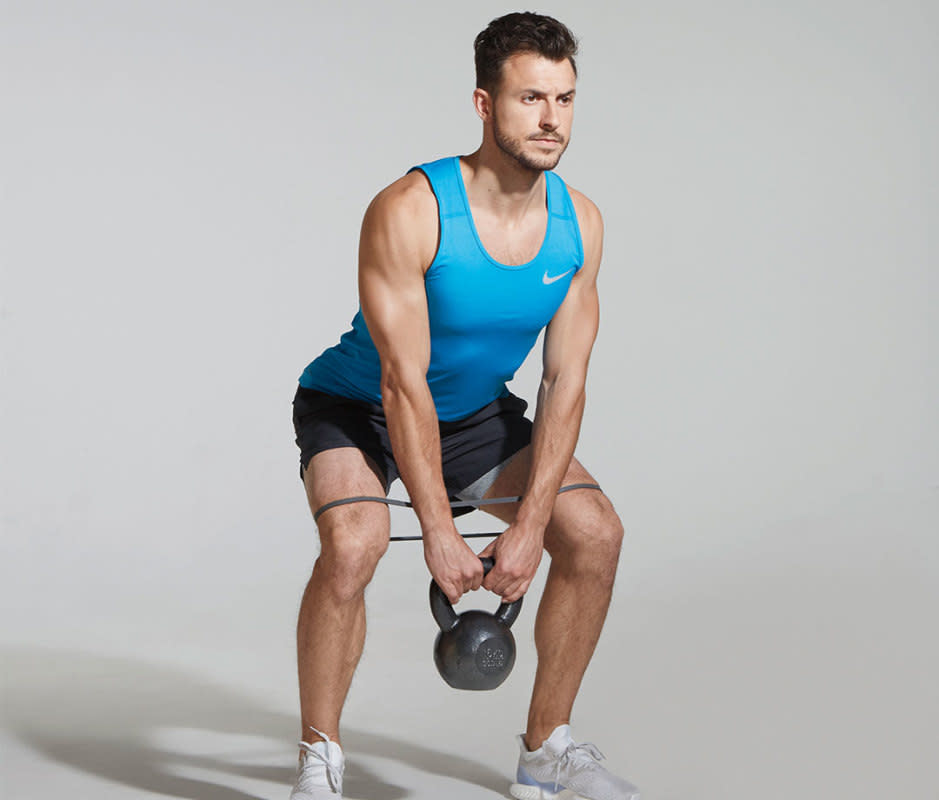
- Place a band around thighs, just above knees, and stand with feet just wider than shoulder-width apart, holding a moderate (30–40 pound) kettlebell in both hands.
- Hinge at hips and push butt back as you lower your torso and KB toward the floor, maintaining tension in your hamstrings and glutes.
- Push through heels to stand.
- Perform 2 sets of 8 to 10 reps.
- hamstrings
- glutes
- quads
Keep you head elevated so your back doesn't arch.
Variation:This move can be done with dumbbells in each hand, with a barbell, or as a warm-up to a traditional deadlift.
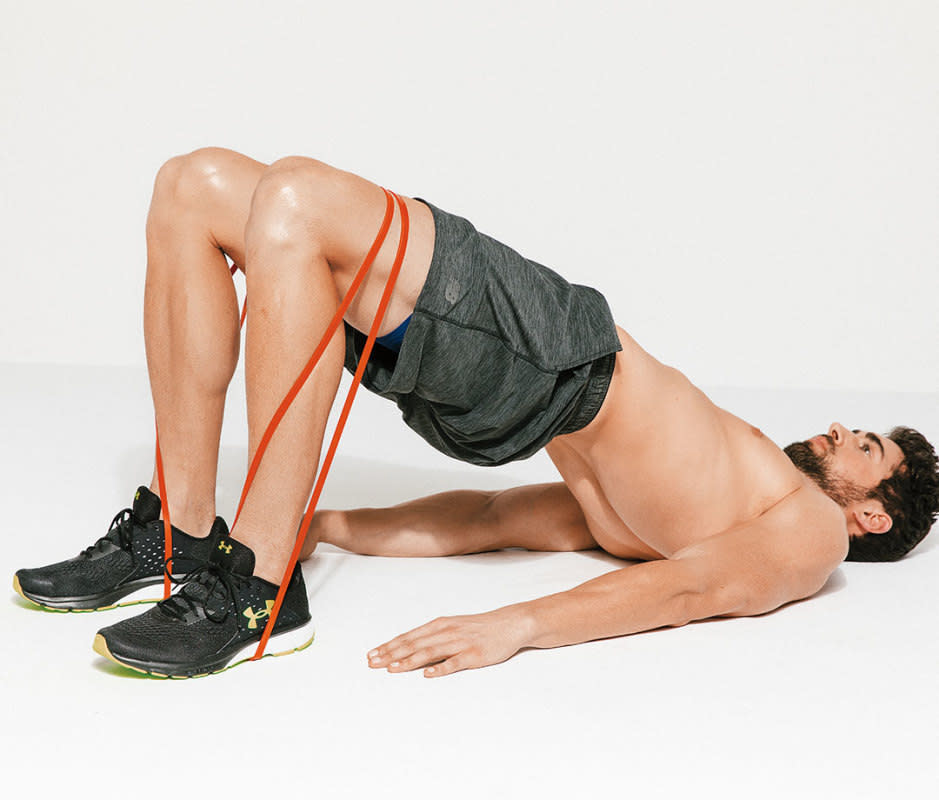
- Sit with knees bent, feet on the floor.
- Drape the resistance band over tops of thighs and secure the ends under each foot.
- Lie back, squeeze glutes and activate core, then press hips toward ceiling.
- Hold for one second, then lower for one rep.
- glutes
- quads
Keep your hips and lower back aligned at the top of the bridge, and bring you hands closer to your body for added support.
Variation:There aren't very many variations to this move, outside of hands placement.

- Hold a kettlebell at face height (it acts as a counterbalance).
- Standing on one foot, lift the other leg behind you, shin parallel to the floor.
- Shift hips back and slowly lower until shin meets the floor. Press through the standing heel to reverse.
- quads
- calves
Start with a 10-15-pound kettlebell to manage the movement.
Variation:Start with two feet on the floor and lift the rear leg as you lower your hips. You can also perform this move with arms extended and no additional weight.
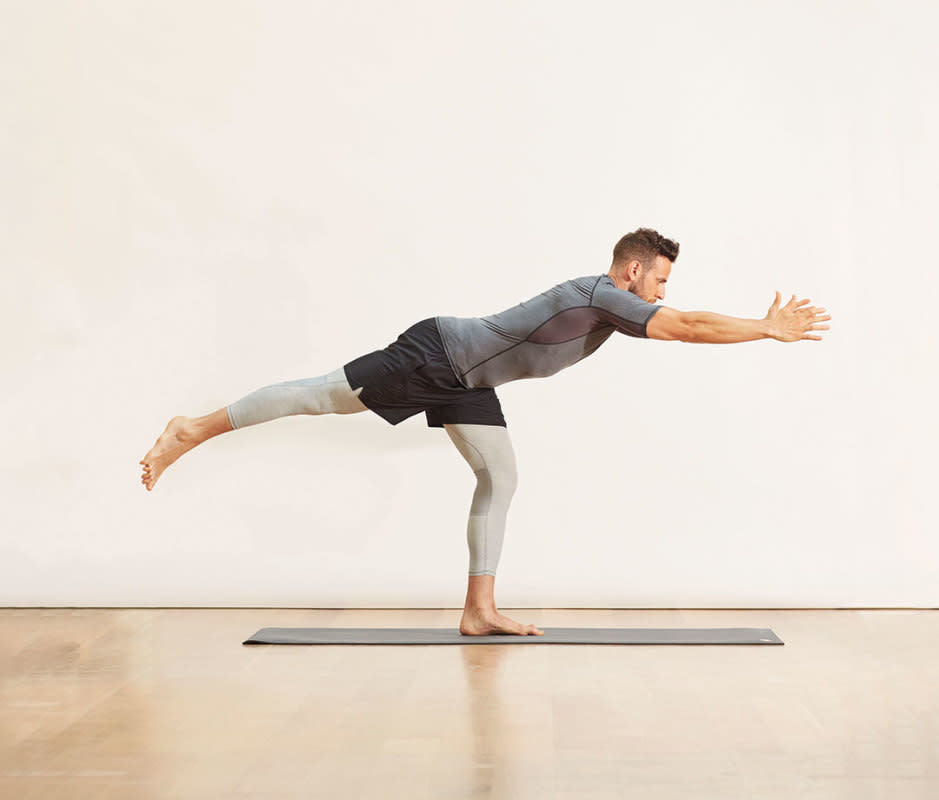
- Stand, feet hip-width apart, to start.
- Shift weight left, inhale, lift right knee to chest, elbows down at sides, palms facing up near chest.
- Exhale, soften left knee, hinge forward, and extend arms, and right leg back.
- Reverse to start, then repeat on the right side for 1 rep.
- hamstrings
- quads
Keep your head neutral to maintain good posture throughout the move.
Variation:This move can be done holding onto a chair with one hand to work one leg and alternating to the other side.

- Step forward with your left leg, and lower your body into a lunge.
- As you go down, place your right hand on the floor so it’s even with your left foot. Your right knee should remain above the floor—not touching.
- Now move your left elbow inside your left foot, and rest it on the floor.
- Square your hips so you feel a stretch on both sides, and try to keep your back as flat as possible.
- Move your left hand outside your left foot, and twist to reach for the sky.
- hip flexors
- quads
Try to pull the toes on your left foot up to your shin for added muscle engagement.
Variation:There are numerous variations to this move, including several seated ones like the piriformis stretch and the kneeling hip flexor.

- Stand with your toes on a line.
- Pick a visual in front of you and jump toward that, hammering your arms back quickly as you leap.
- calves
- quads
- hamstrings
To encourage explosion, place a pillow about halfway between your launching and landing points.
Variation:This is a pretty straightforward move, though some may use added weight.

- Stand holding a dowel rod or broomstick above your head.
- Squat back and down until the top of your thighs are parallel to the floor.
- Push from your hips back to a standing position.
- quads
- calves
- glutes
Keeping your neck neutral will help to maintain proper posture throughout the move.
Variation:You may change from a rod to a barbell with weights for advanced work.
